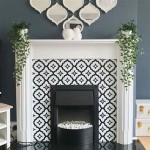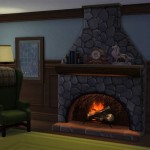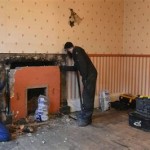Trim Around Fireplace Opening: A Comprehensive Guide
The trim around a fireplace opening, often simply referred to as fireplace trim or fireplace surround trim, serves as both a functional and aesthetic element in a home. It frames the fireplace opening, providing a finished look while also protecting the surrounding wall from heat and potential damage. The selection, installation, and maintenance of this trim are crucial aspects of fireplace design and functionality. A well-chosen and properly installed trim can significantly enhance the overall appearance of a room, while a poorly executed installation can detract from its aesthetic appeal and potentially compromise safety.
Fireplace trim encompasses a variety of materials, styles, and installation methods. Understanding these options is essential for homeowners seeking to upgrade their existing fireplace or incorporate a fireplace into a new construction project. The following sections will delve into the key considerations for selecting, installing, and maintaining fireplace trim, covering different material types, design considerations, and safety precautions.
Material Selection for Fireplace Trim
The material selected for fireplace trim profoundly influences its appearance, durability, and safety. Several options are commonly available, each with its own set of advantages and disadvantages.
Wood: Wood is a classic and versatile choice for fireplace trim. It offers a warm, inviting aesthetic and can be easily shaped and customized to match existing décor. Popular wood species for fireplace trim include oak, maple, pine, and cherry. Each wood type possesses a unique grain pattern and color, allowing for a wide range of design possibilities. However, wood is combustible and must be installed with appropriate clearances from the firebox. It is crucial to ensure that wood trim is adequately protected from the heat source, typically through the use of non-combustible facing materials around the firebox opening. Fire-retardant coatings can also be applied to wood trim to enhance its safety and reduce the risk of ignition. Furthermore, wood trim requires regular maintenance, including painting or staining, to protect it from moisture and wear.
Stone: Stone, including materials like marble, granite, slate, and limestone, provides a durable and elegant option for fireplace trim. Stone is inherently non-combustible, making it a safe choice for placement near the firebox. It offers a natural and timeless aesthetic that complements a variety of architectural styles. Stone trim can be fabricated in various shapes and sizes, allowing for custom designs. However, stone is a relatively heavy material, requiring a robust support structure. Installation of stone trim typically requires professional expertise to ensure proper alignment and secure attachment. Stone is also a more expensive material compared to wood or manufactured options.
Tile: Tile is another versatile and durable option for fireplace trim. Ceramic and porcelain tiles are available in a wide array of colors, patterns, and textures, offering endless design possibilities. Tile is also non-combustible and easy to clean, making it a practical choice for high-use fireplaces. Tile can be installed directly onto the wall surrounding the firebox, providing a protective and aesthetically pleasing surface. The installation of tile trim typically involves applying thin-set mortar to the wall and carefully positioning each tile. Grout is then used to fill the spaces between the tiles, creating a waterproof and durable surface. Tile offers a relatively cost-effective solution for fireplace trim compared to stone or custom wood designs.
Metal: Metal, such as cast iron, steel, and brass, can provide a sleek and modern aesthetic for fireplace trim. Metal is non-combustible and durable, making it a safe and long-lasting option. Cast iron trim is often used in traditional fireplace designs, offering intricate details and a classic look. Steel and brass trim are more commonly found in contemporary designs, providing clean lines and a minimalist aesthetic. Metal trim can be customized with various finishes, including powder coating, painting, and polishing. However, metal can become hot to the touch when the fireplace is in use, so it's crucial to consider its placement and ensure that it is not easily accessible to children or pets. Professional installation is often recommended for metal trim to ensure proper attachment and safety.
Manufactured Materials: Manufactured materials, such as composite wood and faux stone, offer a cost-effective alternative to natural materials. These materials are designed to mimic the appearance of wood or stone while offering improved durability and resistance to moisture. Composite wood trim is often made from recycled wood fibers and resins, providing an environmentally friendly option. Faux stone trim is typically made from lightweight concrete or polyurethane, making it easier to install than natural stone. Manufactured materials are available in a wide range of styles and colors, allowing homeowners to achieve the desired aesthetic at a lower cost. However, it's crucial to select high-quality manufactured materials that are specifically designed for fireplace applications. Low-quality materials may not be as durable or heat-resistant as natural options.
Design Considerations for Fireplace Trim
The design of the fireplace trim should complement the overall style of the room and enhance the fireplace's aesthetic appeal. Several factors should be considered when selecting the design, including the architectural style of the home, the size and shape of the fireplace opening, and the desired aesthetic.
Architectural Style: The architectural style of the home should guide the selection of fireplace trim. For example, a traditional home may benefit from a classic wood trim with intricate details, while a modern home may be better suited for a minimalist metal or stone trim. Matching the trim to the existing architectural details will create a cohesive and harmonious look.
Size and Shape: The size and shape of the fireplace opening should also influence the design of the trim. A large fireplace opening may require a more substantial trim to balance its proportions, while a smaller opening may benefit from a simpler, more understated trim. The shape of the opening, whether it is rectangular, arched, or circular, should also be considered when selecting the trim. The trim should complement the shape of the opening and enhance its visual appeal.
Aesthetic Preference: Ultimately, the selection of fireplace trim is a matter of personal preference. Homeowners should consider their desired aesthetic and choose a trim that reflects their personal style. Whether they prefer a traditional, modern, rustic, or eclectic look, there are countless options available to suit their taste.
Mantel Integration: Often the fireplace trim is integrated with a mantel. The mantel acts as a shelf above the fireplace, providing a focal point for decorative items. The mantel and trim should be designed together to create a cohesive and balanced look. The size, style, and material of the mantel should complement the trim and the overall design of the fireplace.
Color and Finish: The color and finish of the fireplace trim should also be carefully considered. The trim can be painted, stained, or left natural, depending on the desired aesthetic. The color and finish should complement the surrounding wall color and the overall color scheme of the room. A contrasting color can be used to create a bold statement, while a matching color can create a more subtle and cohesive look.
Installation and Safety Precautions for Fireplace Trim
Proper installation and adherence to safety precautions are essential for ensuring the functionality and longevity of fireplace trim. Incorrect installation can compromise the trim's appearance and potentially create a fire hazard.
Clearance to Combustible Materials: One of the most important safety considerations is maintaining adequate clearance between the fireplace opening and any combustible materials. Building codes typically specify minimum clearances for wood trim and other combustible materials. These clearances are designed to prevent the wood from overheating and potentially igniting. Ensure any combustible trim is installed beyond the specified clearances or is shielded by non-combustible materials.
Professional Installation: While some homeowners may be comfortable installing fireplace trim themselves, professional installation is often recommended, particularly for complex designs or when working with heavy materials like stone. Professional installers have the expertise and tools necessary to ensure proper alignment and secure attachment of the trim.
Non-Combustible Facing: In cases where combustible materials, such as wood, are used for fireplace trim, it is essential to install non-combustible facing materials around the firebox opening. These materials, such as brick, stone, or metal, provide a protective barrier between the fire and the combustible trim.
Fire-Retardant Coatings: Fire-retardant coatings can be applied to wood trim to enhance its fire resistance. These coatings are designed to slow down the rate at which wood ignites and burns, providing valuable time to extinguish a fire. However, fire-retardant coatings are not a substitute for proper clearance and non-combustible facing materials.
Regular Inspections: Regularly inspect the fireplace trim for signs of damage or wear. Cracks, warps, or discoloration can indicate a problem that needs to be addressed. If any damage is detected, it should be repaired promptly to prevent further deterioration and maintain safety.
Maintenance: The specific maintenance requirements for fireplace trim will vary depending on the material. Wood trim should be painted or stained regularly to protect it from moisture and wear. Stone and tile trim can be cleaned with a mild detergent and water. Metal trim may require occasional polishing to maintain its luster. Regular maintenance will help to prolong the life of the trim and keep it looking its best.
In summary, selecting, installing, and maintaining fireplace trim require careful consideration of material properties, design aesthetics, and safety precautions. By understanding these factors, homeowners can create a fireplace that is both beautiful and functional, enhancing the overall appeal and value of their home.

Fireplace Trim Kit

Fireplace Trim

Adding Visual Interest And Height To Your Fireplace Remodelando La Casa

Diy Fireplace Finished Addicted 2 Decorating

New York Interior Design Evelyn Benatar Blog Home Fireplace Remodel Marble Surround

Help Edging Trim For Fireplace Heart Hometalk

Diy Fireplace Part 5 Trim Grout And Mantel Addicted 2 Decorating

Fireplace Tile Surround Art Renovation

Simple Mantel Makeover By Adding Trim Molding She Holds Dearly

Heartland Remodeling Llc Quality Tile Trim For St Charles County And Beyond








